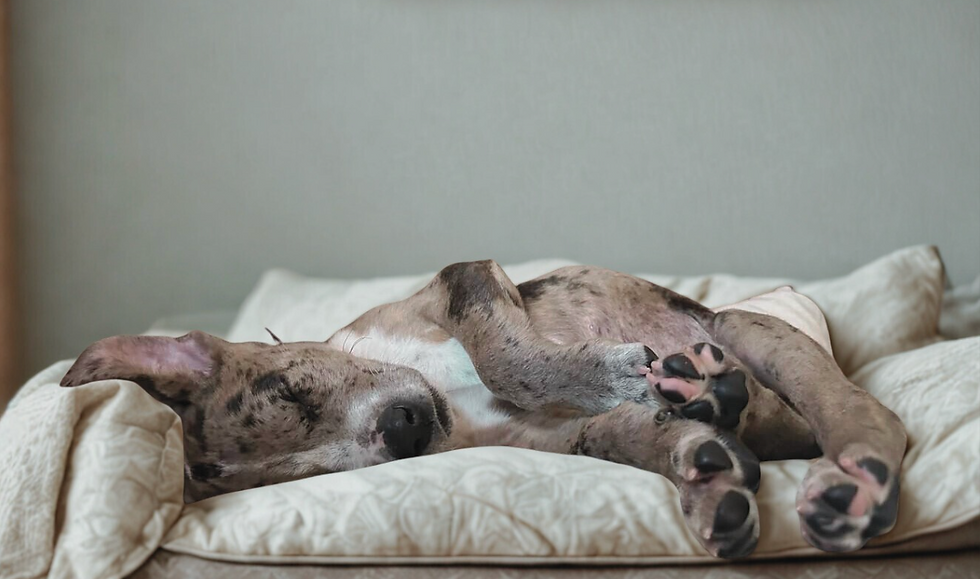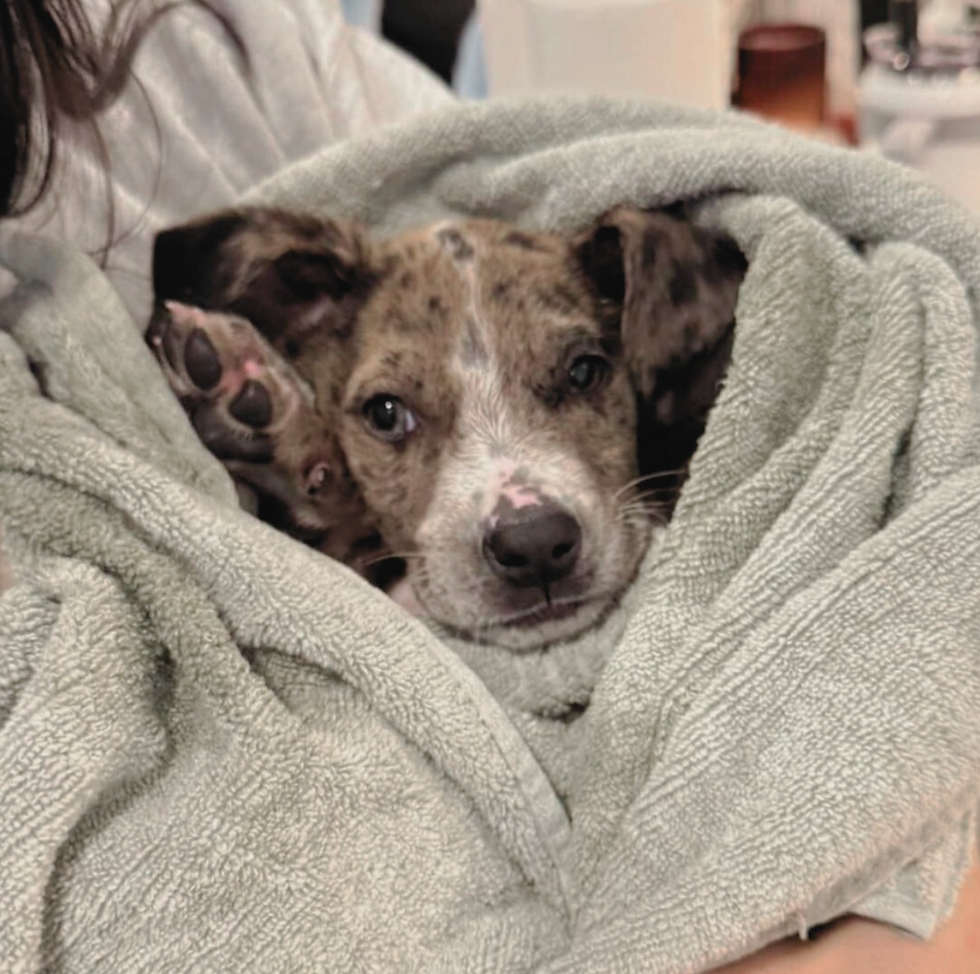🐾 BEYOND DUSTING: Essential Deep Cleaning Secrets for All Pet Parents 🦴
- The Clutterless Company

- 5 days ago
- 6 min read
Living with a high-shedding dog or cat means living with fur, EVERYWHERE. It clings to your clothes, floats into corners, and somehow always reappears minutes after you’ve cleaned. But what most pet owners don’t realize is that shedding isn’t just a surface-level problem. Along with visible hair, your home also collects microscopic dander, oils, and proteins that settle into vents, fabrics, and hidden spaces. Over time, this buildup can leave your home smelling stale, looking dull, and even triggering allergy symptoms.
The good news? With the right strategy, you can stay ahead of it. At The Clutterless Company, we specialize in helping busy households create fresh, healthy spaces, even with the heaviest shedders. These 5 often-overlooked deep cleaning tips go beyond daily vacuuming and lint-rolling to target the hidden places where fur, dander, and pet odors truly live. Mastering these steps will make your home feel brighter, fresher, and genuinely clutterless.

1️⃣ Vacuum Behind,Under and Around Appliances
As pet parents, we’re used to finding fur on floors, couches, and pretty much everywhere else. However, pet hair has a way of drifting into the warm, hidden spaces behind refrigerators, stoves, and laundry machines. Left untouched, it collects dust, clogs vents, and can even pose a fire hazard. That’s why it’s essential to deep clean these spots at least once every season.
Directions:
⦾ Step 1: Vacuum Thoroughly
Start by carefully pulling each appliance away from the wall. Use a vacuum with a crevice tool or long attachment to remove all visible hair, dust, and debris from the floor and baseboards. Pay special attention to corners where fur tends to clump together.
⦾ Step 2: Dry Wipe to Capture Loose Hair
Spray the area with your preferred multipurpose cleaner and wipe it down using dry paper towels or a dry microfiber cloth. This step lifts residual pet hair that sticks to surfaces after vacuuming. Dry wiping first helps prevent hair from smearing or clumping when moisture is added.
⦾ Step 3: Wet Wipe for a Deep Clean
Once the space is hair-free and dry, spray again with your chosen multipurpose cleaner. This time, wipe down using a damp microfiber cloth. The wet wipe ensures oils, sticky dust, and lingering pet residue are fully removed, leaving the area fresh and sanitized.
Pro Tip: Always finish by drying the area completely before sliding appliances back into place to prevent moisture damage or mold.
2️⃣ Wash or Replace Air Vents and Filters
Your HVAC system removes pet dander, microscopic skin flakes, and loose hair fibers throughout every room of your home. Over time, this buildup reduces efficiency, spreads allergens, and contributes to that lingering “dog smell.” To keep your system running clean and your air fresh, follow this step-by-step routine:
Directions:
⦾ Step 1: Remove Vent Covers
Carefully unscrew or lift vent covers from walls, floors, or ceilings. Set them aside near a sink or tub for washing. (Also applicable to any portable HEPA Air Purifier).
⦾ Step 2: Soak in Hot, Soapy Water
Place vent covers in a basin or bathtub filled with hot water and a mild dish soap. Let them soak for 10–15 minutes to loosen sticky fur oils and dust.
⦾ Step 3: Scrub Away Residue
Use a soft brush or an old toothbrush to scrub the covers, especially between slats where hair clings. Rinse thoroughly and allow to air dry.
⦾ Step 4: Vacuum Inside the Vent
While covers are drying, use a vacuum with a hose attachment to remove dust, hair, and debris inside the vent opening.
⦾ Step 5: Replace with a HEPA Filter
Swap out your old HVAC filter for a HEPA-rated filter, which captures fine pet dander and allergens. In homes with high-shedding pets, replace filters monthly instead of seasonally.
⦾ Step 6: Reinstall Clean Vent Covers
Once covers are fully dry, reinstall them. Your air will circulate cleaner, fresher, and more efficiently.
Pro Tip: Mark your calendar or set a phone reminder so this becomes a consistent part of your cleaning schedule.

3️⃣ Deep Clean Base Boards and Wall Trims
Cats LOVE to rub their scent glands along walls, and dogs often brush their coats against baseboards as they move through the house. Over time, these areas soak up fur oils and collect dust, creating stubborn “shadow lines” that vacuums can’t fully remove. Even if your pets don’t rub directly against the walls, fur and dander naturally settle along edges and trim, turning these overlooked spots into hidden magnets for odors and allergens. To refresh your home and get rid of the buildup, try this simple cleaning routine:
⦾ Step 1: Dust the Surface
Use a microfiber duster or dry cloth to remove loose hair and surface dust from baseboards and trim. This prevents smearing once you introduce moisture.
⦾ Step 2: Prepare a Cleaning Solution
Mix warm water with a splash of white vinegar and a small drop of dish soap. The vinegar breaks down oils, while the soap lifts sticky residue.
⦾ Step 3: Wipe with Microfiber Cloth
Dip a microfiber cloth into the solution, wring it out until just damp, and wipe baseboards and wall trim thoroughly. Work in small sections to make sure you capture both fur and oils.
⦾ Step 4: Target Stubborn Spots
For scuff marks or heavy buildup, use a melamine sponge (like a Magic Eraser). Gently scrub to lift grime without damaging the paint finish.
⦾ Step 5: Dry to Finish
Go back over the area with a dry microfiber cloth or paper towel to prevent streaking and stop moisture from seeping into trim or wall edges.
Pro Tip: Repeat this deep clean once per season, or more often if you have multiple high-shedding pets. Clean baseboards not only look fresh but also eliminate invisible odor-carrying oils most pet owners overlook.

4️⃣ Wash Windows, Curtains, and Blinds
Windows and their coverings are some of the most underestimated cleaning hotspots in a pet owner’s home. Beyond the obvious nose prints and paw smudges on glass, fur and dander collect in tracks and seals, where moisture can quickly turn them into grime or even mold.
Meanwhile, curtains act like odor sponges, absorbing pet smells and kitchen aromas, while blinds trap dust and hair along every slat. When overlooked, these areas leave your home dull, smelling stale, and triggering allergy symptoms. With regular care, they can instead brighten your space and keep it feeling fresh.
Directions:
⦾ Step 1: Vacuum Tracks and Frames
Use a vacuum hose with a crevice tool to pull fur, dander, and dust from window tracks, frames, and seals. This clears the bulk of the buildup before you introduce moisture.
⦾ Step 2: Scrub Away Grime
Mix baking soda with a little water to form a paste. Use an old toothbrush to scrub corners and edges where fur clumps stick. Wipe down seals with a vinegar-water solution to kill mildew and neutralize odors.
⦾ Step 3: Clean the Glass
Spray glass with a streak-free, ammonia-free cleaner (or a vinegar and water mix). Wipe nose prints and paw smudges with a microfiber cloth until clear and streak-free.
⦾ Step 4: Wash Curtains
Launder curtains every 3–6 months, or more frequently if you have multiple pets. Use fragrance-free detergent to avoid irritating sensitive pet noses. Dry thoroughly before rehanging to prevent mildew.
⦾ Step 5: Detail Clean Blinds
Vacuum blinds with a brush attachment to remove fur. Followed by wiping each slat with a damp microfiber cloth and a pet-safe deodorizing spray to lift dust, oils, and lingering odors.
Pro Tip: Regular attention to these surfaces reduces allergens and keeps odors from settling deep into fabrics and tracks.

5️⃣ Deep Clean Upholstery to Remove Hidden Pet Oils, Oils, Dander, Fur, Etc.
Vacuuming pet hair from sofas and chairs only tackles the surface. What you can’t see are the microscopic oils, saliva proteins, and bacteria that sink deep into upholstery fibers. This buildup is why some furniture smells “doggy” even after a fresh vacuum.
Directions:
⦾ Step 1: Vacuum Thoroughly
Use a vacuum with an upholstery attachment to remove loose fur, crumbs, and dander from cushions, seams, and crevices.
⦾ Step 2: Treat Stains with Enzymatic Cleaner
For drool spots, urine accidents, or greasy fur patches, apply a pet-safe enzymatic cleaner. Unlike traditional cleaners, enzymes break down organic residue at the source rather than just masking odors.
⦾ Step 3: Steam or Shampoo Upholstery
Use a portable carpet and upholstery cleaner or rent a steam machine quarterly. Work slowly across all cushions and backs, allowing the machine to extract deep-set oils and bacteria.
⦾ Step 4: Rotate and Refresh Cushions
Once dry, rotate cushions to even out wear from your pet’s favorite nap spot. This extends fabric life and prevents permanent indentations from fur oils.
Pro Tip: For high-shedding or multi-pet homes, aim to deep clean upholstery every 2–3 months instead of just once a season.



Comments